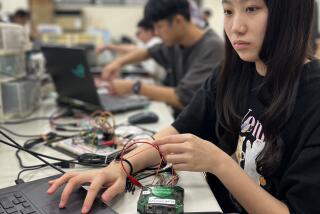Japan’s Plans to Boost Chip Output Raise Fear of Glut : Technology: With its investment, and competition from other nations, supply is likely to exceed demand--and exacerbate relations.
In their mad rush to position themselves for the next wave of microchip production, Japan’s giant semiconductor firms may end up clogging the market just as they did five years ago.
The companies are pouring money into building production capacity that will likely exceed demand, a situation that in the mid-1980s forced them to dump chips at low prices and sparked a trade dispute with the United States.
But the firms say they remember their history and are not condemned to repeat it. “We have learned a lot from that mistake, and now we know how to control prices and balance demand and supply,” a Toshiba Corp. spokesman said. “We will not make the same mistake.”
Some industry analysts are not so sure. They say fierce competition in the memory chip game--from U.S. and European manufacturers as well as new entrants in South Korea and Taiwan--will eat away at Japan’s control of the market for four-megabit dynamic random access memory (DRAM) microchips.
“Their investments are so great, they will lose money unless they crank the chips out. There will be significant oversupply of four-megabit DRAMs by mid-1991,” said Chuck Goto, senior analyst at S. G. Warburg Securities (Japan).
Total Japanese capital investment in these chips will reach $1.7 billion by December this year, which will enable a total monthly production of about 20 million chips by year-end, another analyst estimated.
Barring an unexpected upturn in the U.S. personal computer market, that amount will far exceed demand, according to Dataquest, a U.S. market research firm.
Global demand for four-megabit DRAMs will be less than 25 million units for all 1990 and will rise to 119 million in 1991 and 400 million in 1992, Dataquest said.
Production by South Korean, Taiwanese, U.S. and European firms could further bloat the microchip market.
“Japanese makers are likely to control their production, but there is still concern about oversupply,” said an analyst at a Japanese research institute.
Companies outside Japan also have invested massive sums to compete for memory chip technology, one of the foundations of the electronics industry.
Fortunately for Japan’s rivals, demand for four-megabit DRAMs has grown more slowly than expected. This lag has given competitors time to close in on Japan’s waning technological lead.
All the players want to boost output to reduce costs per unit, which would allow them to cut prices in hopes of gaining market share.
Already, soft prices for four-megabit DRAMs are pressuring novice chip makers to outproduce their venerable rivals. Japanese firms may then have no choice but to produce more too, thus increasing excess supplies.
Many industry analysts, however, believe that this time Japanese firms will not be left holding the overflowing supply bag that caused them huge losses in the mid-’80s.
The glut hit U.S. firms even harder, forcing many out of business. Washington, angered by Japanese dumping, negotiated the 1986 Japan-U.S. semiconductor pact in which Tokyo pledged not to sell chips below cost and to improve access to its domestic market.
Tokyo now prizes its relations with the United States and would rather suffer a slight erosion of its market share than risk Washington’s wrath, some analysts say.
“There is almost no possibility of oversupply of four-megabit DRAMs in the near future,” said Shigeru Yoshinaka, an analyst at Wako Research Institute of Economics.






